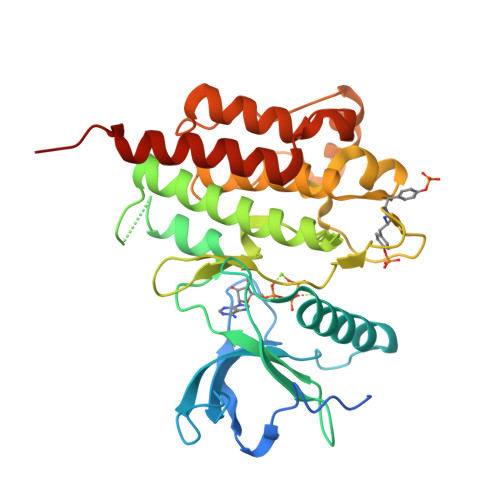A crystallographic snapshot of tyrosine trans-phosphorylation in action
Chen, H., Xu, C.F., Ma, J., Eliseenkova, A.V., Li, W., Pollock, P.M., Pitteloud, N., Miller, W.T., Neubert, T.A., Mohammadi, M.(2008) Proc Natl Acad Sci U S A 105: 19660-19665
- PubMed: 19060208
- DOI: https://doi.org/10.1073/pnas.0807752105
- Primary Citation of Related Structures:
3CLY - PubMed Abstract:
Tyrosine trans-phosphorylation is a key event in receptor tyrosine kinase signaling, yet, the structural basis for this process has eluded definition. Here, we present the crystal structure of the FGF receptor 2 kinases caught in the act of trans-phosphorylation of Y769, the major C-terminal phosphorylation site. The structure reveals that enzyme- and substrate-acting kinases engage each other through elaborate and specific interactions not only in the immediate vicinity of Y769 and the enzyme active site, but also in regions that are as much of 18 A away from D626, the catalytic base in the enzyme active site. These interactions lead to an unprecedented level of specificity and precision during the trans-phosphorylation on Y769. Time-resolved mass spectrometry analysis supports the observed mechanism of trans-phosphorylation. Our data provide a molecular framework for understanding the mechanism of action of Kallmann syndrome mutations and the order of trans-phosphorylation reactions in FGFRs. We propose that the salient mechanistic features of Y769 trans-phosphorylation are applicable to trans-phosphorylation of the equivalent major phosphorylation sites in many other RTKs.
Organizational Affiliation:
Department of Pharmacology and Kimmel Center for Biology and Medicine at Skirball Institute, New York University School of Medicine, New York, NY 10016, USA.




















